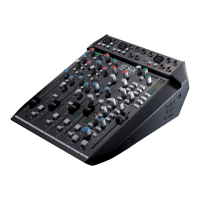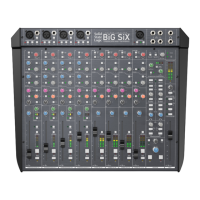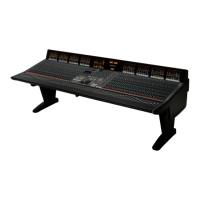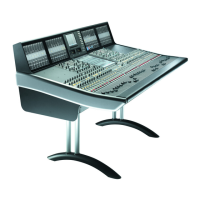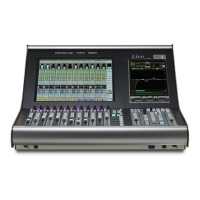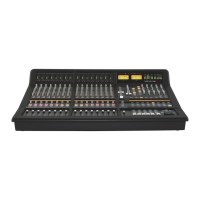Following the input stage, the signal passes via the EQ and Dynamics sections (if
selected) to the Small Fader. The Channel signal can also be fed via the insert points to
an external device (not shown on the diagram) which can be switched pre or post the
EQ.
After passing through the Small Fader and associated pan, the signal is sent to the
Multitrack Routing Matrix, via the default selection of the associated SF (Small Fader)
routing source button. When recording to a stereo pair of tracks, the Small Fader pan
can be used to pan source signals between odd and even multitrack busses.
From the Routing Matrix the Channel signal passes on to the multitrack busses, to be
picked up by the bus mix amp associated with that multitrack bus/Group. The Bus
Trim may be on another module if the channel has been routed to a bus other than its
own (which is usually the case). The signal then passes (via the FADER switch) on to
the Group Output patch point on Row G, where it is normalled to the Multitrack Send
and Group Monitor Input on Row H. The Multitrack Return appears on Row J and is
normalled to the Tape Monitor Input (Row K).
Both these Tape and Group Monitor signals feed a switching matrix which is
controlled by the GROUP and TAPE buttons (see Section 3 for more details). Note that
selection of MASTER READY GROUP on the SL952J selects all Monitor path inputs
to GROUP automatically. This can be a useful starting point if you are recording to a
large number of tracks simultaneously.
If required, the monitor signal can now be processed with the EQ and Dynamics
sections (which can be switched into the Monitor or Channel signal paths, see Section
4). The signal passes on via the Large Fader and out of the module onto the Mix bus.
The Mix bus is fed into summing amps in the centre section and then passes via the
Main Fader out to the monitor amps and ATRs.
Remember that, in RECORD status, the Large Faders relate to the monitoring of
multitrack sends and returns, and the Small Faders relate to whatever source is being
fed into that channel. Quite often these two signals may be completely different. For
example, Track 7 may be fed from a mic plugged into Channel 1. The Small Fader on
Channel 1 will control the level of that mic to the multitrack machine, the Large Fader
on Channel 7 will control the level of Track 7 sends and returns as heard on the
monitors.
Provision has been made for an analogue multitrack tape machine output to
automatically switch to Sync whenever the RECORD status button is selected. This
may, or may not, be wired in your studio.
Basic Routing and Signal Flow
2-9
5.9.96

